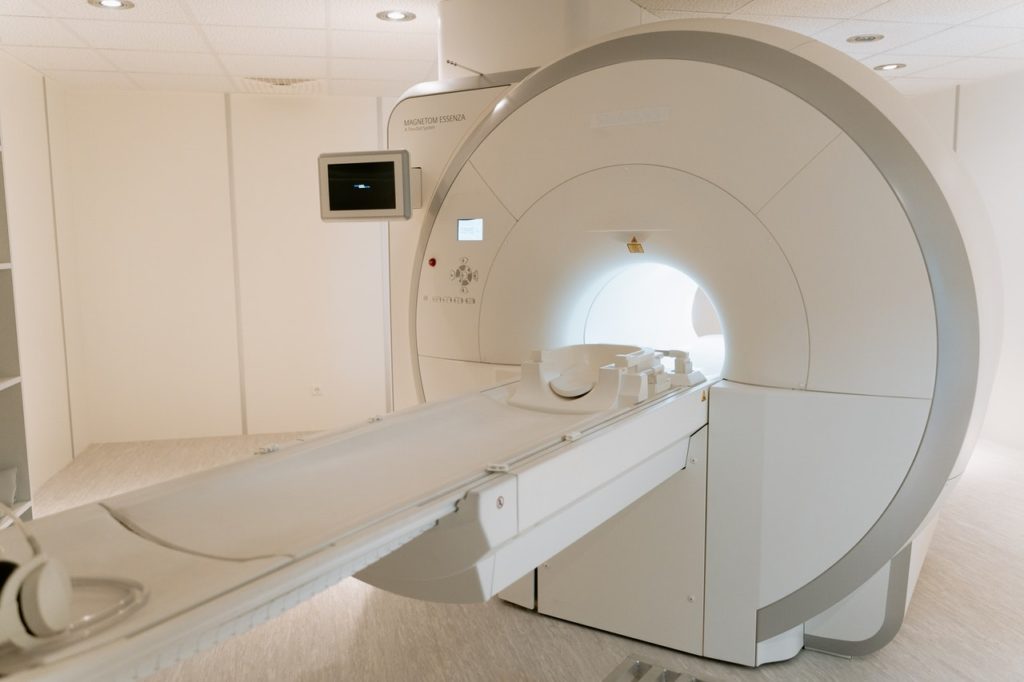
I learned this today. An MRI works by causing the protons in the hydrogen nuclei in our bodies to align with a magnetic field and then disrupts them with a radio wave.
Our bodies contain about 60% water, but this figure changes depending on the organ. All of the organs in our body, our tissue, and our fat contain a lot of water.
An MRI is a Magnetic Resonance Imager. It works by sending a strong magnetic field through the body. The protons in the hydrogen nuclei in the body all have a north and a south, but they spin at random angles. When they spin, they create a small magnetic charge. The MRI sends a magnetic pulse through the part of the body being tested and all of the hydrogen protons align with that magnetic field. Then a radio wave is sent through the patient. This causes the proton to resonate and turn at right angles to the magnetic field, going out of alignment. When the radio wave is switched off, the protons realign with the magnetic field and release electromagnetic energy as a radio wave. The time it takes for the protons to realign and the amount of energy they give off is measured by the MRI machine. The speed that the protons return to alignment with the magnetic field varies depending on the type of tissue. The radio waves from the protons are picked up by a radiofrequency coil. A computer then translates the signals into a 3D image.
MRI tests are far better than X-ray or CT scans because they don’t use any radiation. The only thing they use is a magnetic field, something we are surrounded by all of the time. X-rays are far more dangerous as they are obviously radiation. X-rays cannot see through bone very well and bone might hide an area of disease. X-rays also have trouble telling tissues apart. MRI scans don’t have any of these problems. The only disadvantages of MRI scans are that you have to be immobilized inside the machine for quite a long time, and they are extremely noisy. The noise comes from the coils inside the machine. A current is passed through gradient coils inside the machine. This creates a magnetic field. When the electricity is rapidly pulsed, it causes the coils to expand and make the cracking banging sound you can hear.
Because of the strong magnetic field, you cannot have metal objects near the machines. People with metal implants in their bodies, or pacemakers, cannot use MRI machines. There is an urban legend that tattoos will be attracted to the magnet and ripped out of your skin, but that is not true. Tattoos do contain some metals, but not at high enough concentrations to be attracted to the magnet. There are reports of about 1 in 1000 people having tingling feelings or slight burns on the tattoo because it creates an electrical current, but this is extremely rare.
MRI scans are very good at picking up diseases because a lot of diseases have an increased water content. At first glance a tumor and an infection can look the same on an MRI scan, but a trained professional should be able to tell them apart.
Magnetic Resonance Imaging was invented by Paul C Lauterbur in 1971, but his discovery would not have come about without the many discoveries that went before him.
So, an MRI works by creating a magnetic field to align the protons in the nuclei of the hydrogen in your body. It then sends in a radio wave to knock the protons out of alignment. When the radio wave is switched off, the protons go back into alignment, releasing energy in a radio wave. The time it takes for the protons to realign and the amount of energy they release can tell a computer what type of tissue they are coming from and the computer can construct an image. And that is how an MRI works and that is what I learned today.
Sources
https://en.wikipedia.org/wiki/Magnetic_resonance_imaging
https://en.wikipedia.org/wiki/History_of_magnetic_resonance_imaging
https://www.nibib.nih.gov/science-education/science-topics/magnetic-resonance-imaging-mri
https://mayfieldclinic.com/pe-mri.htm
https://www.ncbi.nlm.nih.gov/pmc/articles/PMC1121941/
